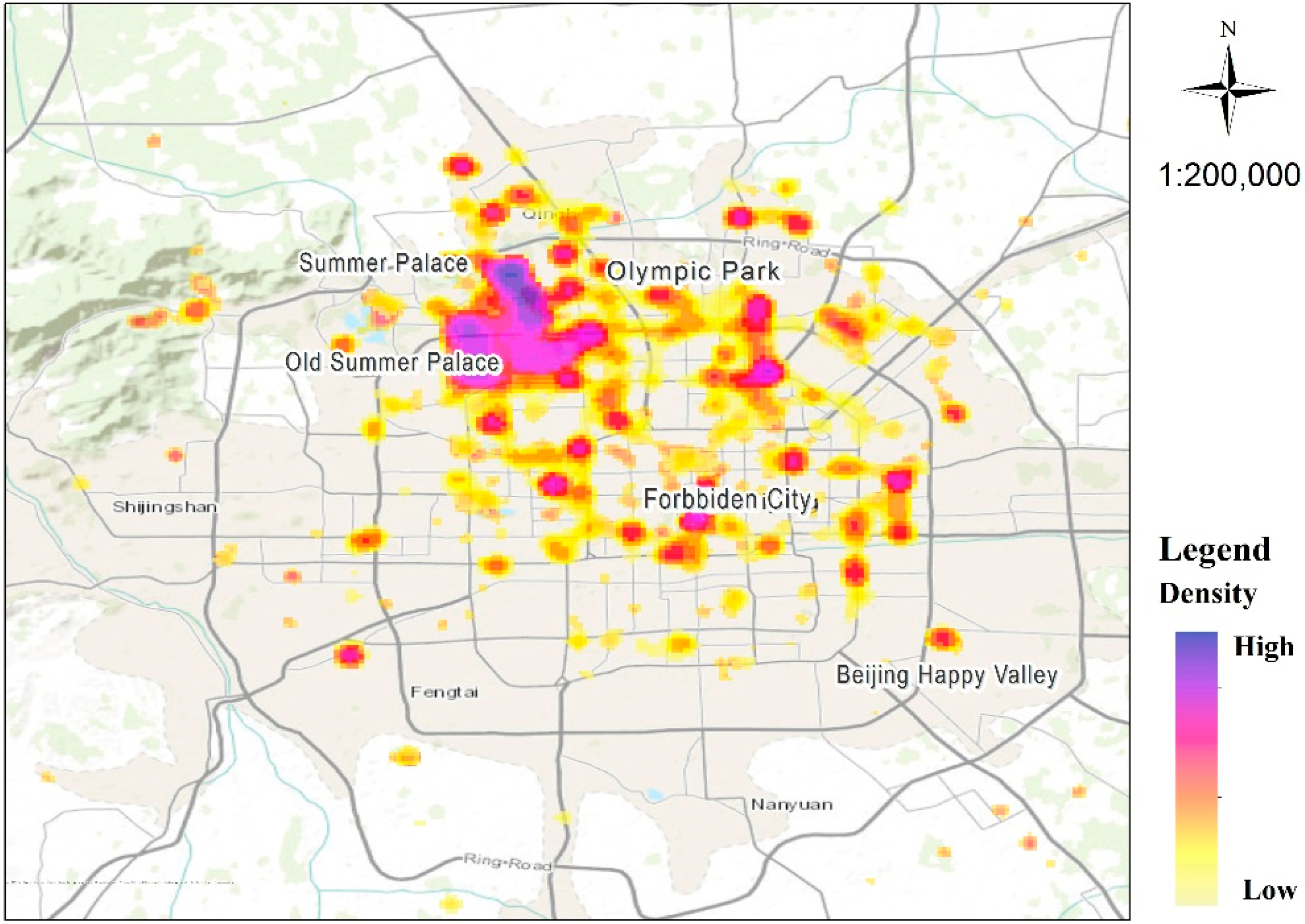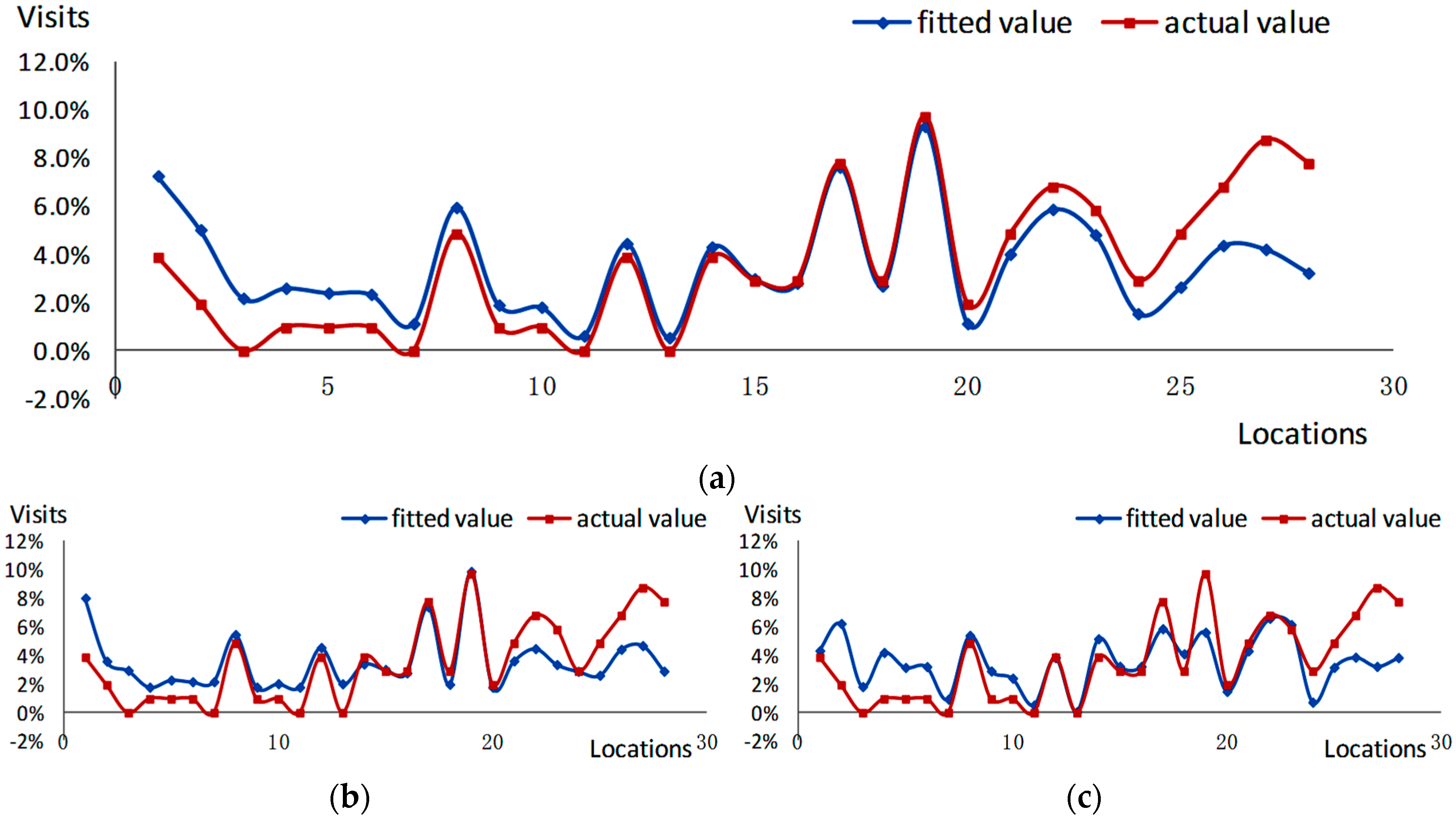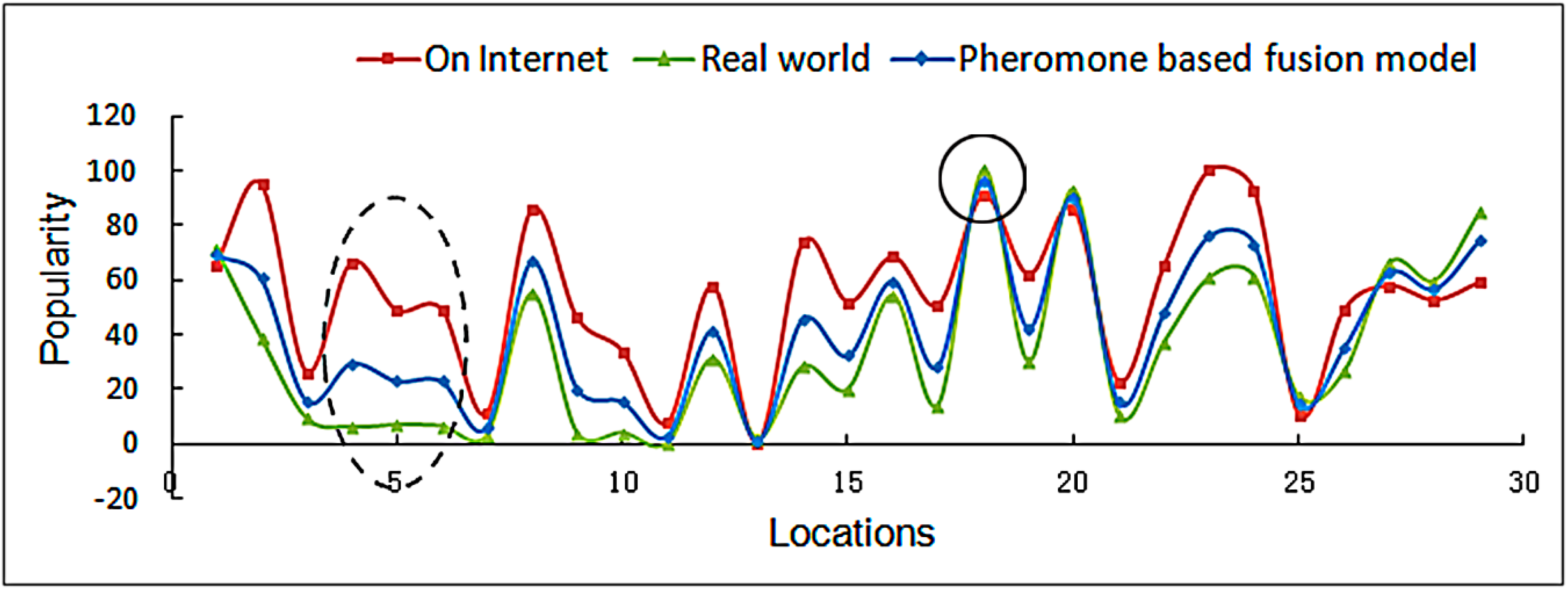Spatio-Temporal Behavior Analysis and Pheromone-Based Fusion Model for Big Trace Data
Abstract
:1. Introduction
1.1. Background and Problem
1.2. Related Work
1.3. Recreational Behavior Analysis and Digital Trace Fusion
2. Foundation Idea of Pheromone-Based Fusion Model
2.1. Pheromone Mechanism in Nature
2.2. The Similarity between Recreation Pattern and Pheromone Pattern
2.3. Concept of Recreational Pheromones in Human Society
3. Pheromone-Based Fusion Model
3.1. Recreational Patterns in the Real Space
3.2. Recreational Pheromones in Cyberspace
3.3. Establishing Proper Weights for Online and Offline Data to Be Fused
4. An Experiment in Beijing
4.1. Experimental Data and Preliminary Analysis
- Identify the trajectory from raw GPS data;
- Compute the velocity of each GPS record and select the low-speed segment (<1.6 m/s);
- Compute the center of each low-speed trajectory segment:where x denotes the processed data and x* is the original data.
4.2. Weights and Volatilization Coefficient
4.3. Comparison of Methods and Evaluation Results
5. Conclusions
Acknowledgments
Author Contributions
Conflicts of Interest
References
- Plog, S.C. Why destination areas rise and fall in popularity. Cornell Hotel Restaur. Adm. Q. 1974, 14, 55–58. [Google Scholar] [CrossRef]
- Lynch, K. Reconsidering the image of the city. In Cities of the Mind: Images and Themes of the City in the Social Sciences; Rodwin, L., Hollister, R.M., Eds.; Springer: Boston, MA, USA, 1984; pp. 151–161. [Google Scholar]
- Debbage, K.G. Spatial behavior in a bahamian resort. Ann. Tour. Res. 1991, 18, 251–268. [Google Scholar] [CrossRef]
- Lew, A.; McKercher, B. Modeling tourist movements—A local destination analysis. Ann. Tour. Res. 2006, 33, 403–423. [Google Scholar] [CrossRef]
- Quercia, D.; Schifanella, R.; Aiello, L.M. The Shortest Path to Happiness: Recommending Beautiful, Quiet, and Happy Routes in the City. In Proceedings of the 25th ACM Conference on Hypertext and Social Media, Santiago, Chile, 1–4 September 2014. [Google Scholar]
- Lloyd, R.E.; Ader, R. A cognitive model for recreational spatial behaviour in an urban area. Southeast. Geogr. 1980, 20, 145–159. [Google Scholar] [CrossRef]
- Otero Pastor, I.; Casermeiro Martinez, M.A.; Ezquerra Canalejoa, A.; Esparcia Marino, P. Landscape evaluation: Comparison of evaluation methods in a region of Spain. J. Environ. Manag. 2007, 85, 204–214. [Google Scholar] [CrossRef] [PubMed]
- Li, F.; Sun, R.H.; Chen, L.D. Recreational attraction of urban park wetlands in Beijing. Chin. J. Appl. Ecol. 2012, 23, 2093–2099. [Google Scholar]
- Giannotti, F.; Nanni, M.; Pinelli, F.; Pedreschi, D. Trajectory Pattern Mining. In Proceedings of the 13th ACM SIGKDD International Conference on Knowledge Discovery and Data Mining, San Jose, CA, USA, 12–15 August 2007. [Google Scholar]
- Giannotti, F.; Nanni, M.; Pedreschi, D.; Pinelli, F.; Renso, C.; Rinzivillo, S.; Trasarti, R. Unveiling the complexity of human mobility by querying and mining massive trajectory data. VLDB J. 2011. [Google Scholar] [CrossRef]
- Ahas, R.; Aasa, A.; Mark, Ü.; Pae, T.; Kull, A. Seasonal tourism spaces in Estonia: Case study with mobile positioning data. Tour. Manag. 2007, 28, 898–910. [Google Scholar] [CrossRef]
- Ahas, R.; Aasa, A.; Roose, A.; Mark, Ü.; Silm, S. Evaluating passive mobile positioning data for tourism surveys: An Estonian case study. Tour. Manag. 2008, 29, 469–486. [Google Scholar] [CrossRef]
- Toader, B.; Sprumont, F.; Faye, S.; Popescu, M.; Viti, F. Usage of smartphone data to derive an indicator for collaborative mobility between individuals. ISPRS Int. J. Geo.-Inf. 2017. [Google Scholar] [CrossRef]
- Zhou, X.L. Understanding spatiotemporal patterns of biking behavior by analyzing massive bike sharing data in Chicago. PLoS ONE 2015. [Google Scholar] [CrossRef] [PubMed]
- Li, L.; Yang, L.; Zhu, H.; Dai, R. Explorative analysis of Wuhan intra-urban human mobility using social media check-in data. PLoS ONE 2015, 10, e0135286. [Google Scholar] [CrossRef] [PubMed]
- Liu, Y.; Sui, Z.; Kang, C.; Gao, Y. Uncovering patterns of inter-urban trip and spatial interaction from social media check-in data. PLoS ONE 2014. [Google Scholar] [CrossRef] [PubMed]
- Jurdak, R.; Zhao, K.; Liu, J.; AbouJaoude, M.; Cameron, M.; Newth, D. Understanding human mobility from twitter. PLoS ONE 2014. [Google Scholar] [CrossRef] [PubMed]
- Zeile, P.; Resch, B.; Exner, J.-P.; Sagl, G. Urban emotions: Benefits and risks in using human sensory assessment for the extraction of contextual emotion information in urban planning. In Planning Support Systems and Smart Cities; Geertman, S., Ferreira, J.J., Goodspeed, R., Stillwell, J., Eds.; Springer International Publishing: Cham, Switzerland, 2015. [Google Scholar]
- Cord, A.F.; Roeßiger, F.; Schwarz, N. Geocaching data as an indicator for recreational ecosystem services in urban areas: Exploring spatial gradients, preferences and motivations. Landsc. Urban Plan 2015, 144, 151–162. [Google Scholar] [CrossRef]
- Zheng, Y.; Zhang, L.; Xie, X.; Ma, W.-Y. Mining Interesting Locations and Travel Sequences from Gps Trajectories. In Proceedings of the 18th Tnternational Conference on World Wide Web, Madrid, Spain, 20–24 April 2009. [Google Scholar]
- McKercher, B.; Shoval, N.; Ng, E.; Birenboim, A. First and repeat visitor behaviour: GPS tracking and GIS analysis in Hong Kong. Tour. Geogr. 2012, 14, 147–161. [Google Scholar] [CrossRef]
- Edwards, D.; Griffin, T. Understanding tourists’ spatial behaviour: GPS tracking as an aid to sustainable destination management. J Sustain. Tour. 2013, 21, 580–595. [Google Scholar] [CrossRef]
- Zheng, Y.; Xie, X. Learning travel recommendations from user-generated gps traces. ACM Trans. Intell. Syst. Technol. 2011, 2, 1–29. [Google Scholar] [CrossRef]
- Chen, Y.Y.; Cheng, A.J.; Hsu, W.H. Travel recommendation by mining people attributes and travel group types from community-contributed photos. IEEE Trans. Multimed. 2013, 15, 1283–1295. [Google Scholar] [CrossRef]
- Crandall, D.J.; Backstrom, L.; Huttenlocher, D.; Kleinberg, J. Mapping the World’s Photos. In Proceedings of the 18th International Conference on World Wide Web, Madrid, Spain, 20–24 April 2009. [Google Scholar]
- Kisilevich, S.; Mansmann, F.; Keim, D. P-dbscan: A Density Based Clustering Algorithm for Exploration and Analysis of Attractive Areas Using Collections of Geo-Tagged Photos. In Proceedings of the 1st International Conference and Exhibition on Computing for Geospatial Research & Application, Washington, DC, USA, 21–23 June 2010. [Google Scholar]
- Gu, Z.; Zhang, Y.; Chen, Y.; Chang, X. Analysis of attraction features of tourism destinations in a mega-city based on check-in data mining—A case study of ShenZhen, China. ISPRS Int. J. Geo.-Inf. 2016, 5, 210. [Google Scholar] [CrossRef]
- Zhang, X.; Zhao, W.D.; Jiang, W.P. Road landscape evaluation and the most beautiful route planning based on big website data. J. Tongji Univ. 2016, 44, 383–388. [Google Scholar]
- Zhu, H.; Liu, J.M.; Tao, H.; Zhang, J. Evaluation and spatial analysis of tourism resources attraction in BeiJing based on the internet information. J. Nat. Res. 2015, 30, 2081–2094. [Google Scholar]
- Subramaniyaswamy, V.; Vijayakumar, V.; Logesh, R.; Indragandhi, V. Intelligent travel recommendation system by mining attributes from community contributed photos. Procedia Comput. Sci. 2015, 50, 447–455. [Google Scholar] [CrossRef]
- Zhang, P.; Deng, M.; Shi, Y.; Zhao, L. Detecting hotspots of urban residents’ behaviours based on spatio-temporal clustering techniques. GeoJournal 2016. [Google Scholar] [CrossRef]
- Chen, J.; Shaw, S.-L. Representing the spatial extent of places based on flickr photos with a representativeness-weighted kernel density estimation. In GIScience 2016: Geographic Information Science; Miller, J.A., O’Sullivan, D., Wiegand, N., Eds.; Springer International Publishing: Cham, Switzerland, 2016. [Google Scholar]
- Hu, Y.; Gao, S.; Janowicz, K.; Yu, B.; Li, W.; Prasad, S. Extracting and understanding urban areas of interest using geotagged photos. Comput. Environ. Urban Syst. 2015, 54, 240–254. [Google Scholar] [CrossRef]
- Dorigo, M.; Maniezzo, V.; Colorni, A. Ant system: Optimization by a colony of cooperating agents. IEEE Trans. Syst. Man. Cybern. Part B 1996, 26, 29–41. [Google Scholar] [CrossRef] [PubMed]
- Deneubourg, J.L.; Goss, S. Collective patterns and decision-making. Ethol. Ecol. Evol. 1989, 1, 295–311. [Google Scholar] [CrossRef]
- Dong, X.L.; Srivastava, D. Big Data Integration. In Proceedings of the 2013 IEEE 29th International Conference on Data Engineering (ICDE), Brisbane, Australia, 8–12 April 2013. [Google Scholar]
- Li, Q.; Li, Y.; Gao, J.; Zhao, B.; Fan, W.; Han, J. Resolving Conflicts in Heterogeneous Data by Truth Discovery and Source Reliability Estimation. In Proceedings of the 2014 ACM SIGMOD International Conference on Management of Data, Snowbird, UT, USA, 22–27 June 2014. [Google Scholar]
- Wu, X.D.; Zhu, X.Q.; Wu, G.Q.; Ding, W. Data mining with big data. IEEE Trans. Knowl. Data Eng. 2014, 26, 97–107. [Google Scholar]
- Malíčková, M.; Yates, C.; Boďová, K. A stochastic model of ant trail following with two pheromones. arXiv 2015. [Google Scholar]
- Fuzzy Clustering. Available online: https://reference.wolfram.com/legacy/applications/fuzzylogic/Manual/12.html (accessed on 26 October 2016).
- Zadeh, L.A. Similarity relations and fuzzy orderings. Inf. Sci. 1971, 3, 177–200. [Google Scholar] [CrossRef]
- Zhu, H.; Feng, J. The hierarchy and distribution of city park in Beijing. Urban Stud. 2008, 4, 76–83. [Google Scholar]
- China Highlights. Available online: http://www.chinahighlights.com/beijing/attraction/ (accessed on 9 October 2015).








| Volatilization Coefficient ρ | R-squared | The Correlation between τ 1 and n 2 |
|---|---|---|
| 0.7 | 0.570 | 0.702 |
| 0.8 | 0.567 | 0.700 |
| 0.9 | 0.575 | 0.719 |
| Non-volatile(1.0) | 0.556 | 0.685 |
| Method | R-squared |
|---|---|
| Based solely on GPS data | 0.497 |
| Based solely on online data | 0.391 |
| Pheromone-based Fusion Model | 0. 575 |
© 2017 by the authors. Licensee MDPI, Basel, Switzerland. This article is an open access article distributed under the terms and conditions of the Creative Commons Attribution (CC BY) license (http://creativecommons.org/licenses/by/4.0/).
Share and Cite
Tang, L.; Zou, Q.; Zhang, X.; Ren, C.; Li, Q. Spatio-Temporal Behavior Analysis and Pheromone-Based Fusion Model for Big Trace Data. ISPRS Int. J. Geo-Inf. 2017, 6, 151. https://0-doi-org.brum.beds.ac.uk/10.3390/ijgi6050151
Tang L, Zou Q, Zhang X, Ren C, Li Q. Spatio-Temporal Behavior Analysis and Pheromone-Based Fusion Model for Big Trace Data. ISPRS International Journal of Geo-Information. 2017; 6(5):151. https://0-doi-org.brum.beds.ac.uk/10.3390/ijgi6050151
Chicago/Turabian StyleTang, Luliang, Qianqian Zou, Xia Zhang, Chang Ren, and Qingquan Li. 2017. "Spatio-Temporal Behavior Analysis and Pheromone-Based Fusion Model for Big Trace Data" ISPRS International Journal of Geo-Information 6, no. 5: 151. https://0-doi-org.brum.beds.ac.uk/10.3390/ijgi6050151






